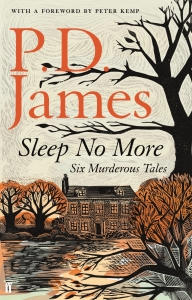Sleep No More – P.D. James
 In the preface to another collection, published by Faber & Faber last year, British crime-writing giant P.D. James wrote that, in a short story, “much has to be achieved with limited means.” The six stories in ‘Sleep No More’ are dazzling proof of just how much can be achieved when an author of P.D. James’ calibre applies her crime and writing savvy to the task.
In the preface to another collection, published by Faber & Faber last year, British crime-writing giant P.D. James wrote that, in a short story, “much has to be achieved with limited means.” The six stories in ‘Sleep No More’ are dazzling proof of just how much can be achieved when an author of P.D. James’ calibre applies her crime and writing savvy to the task.
Writing a short story is like building a miniature device. You have to be pin-point perfect, handling your tools, the short-story’s building blocks, with surgical precision. This applies to setting and characterisation above all, both of which P.D. James – the creator of DCI Adam Dalgliesh and author of nineteen crime novels – fashions with a combination of deftness and economy that is mesmerising.
Especially for the impeccable way in which she treads the information tightrope. Give readers too much, or too much in the wrong place, and the whole fragile edifice goes askew. Give them too little, and they will be groping in the dark, with the annoying suspicion of having missed that crucial element that could make the story come alive for them. P.D. James’ writing is so sharp, adroit and painstakingly precise that even the laziest of readers will feel completely at ease with these stories, will be able to revel in the narratives and be smoothly drawn to their denouement.
In the same preface, P.D. James acknowledged that “the scope of the short story is inevitably restricted, and this means it is most effective when it deals with a single incident.” A corollary is that, in a crime fiction short story, there may not be enough room to develop both a satisfying villain and an engaging detective.
Undaunted, P.D. James takes this in her stride and chooses to focus chiefly on the villains, either making them the stories’ protagonists or blurring the boundaries by sketching deliciously ambiguous, when not downright unreliable, narrators. Not always fully fledged villains themselves, but always characters who play a disturbing part in the story.
Curiously, perhaps by design, most of the protagonists share similar traits: they are reserved, withdrawn, and in some cases solitary individuals. From the mediocre detective fiction writer who does ‘a workmanlike job on the old conventions, for those who like their murders cosy’, to the lonely orphaned girl with a black hole in her past and a yearning to find her father’s grave, or the retired judge who feels he is often no more than an object to be collected and carted around by his family, and hides a long-cached secret. They mostly turn out to be implicated with the crimes featured in the stories they narrate or appear in, though not before P.D. James has exploited them as the springs that make her faultless short-story mechanisms click.
With the exception of ‘The Girl Who Loved Graveyards’, in which P.D. James blends clockwork crime plotting with a dark hint of the Gothic, all the stories feature more than a nod to the classic English crime-writing tradition, à la Dorothy L. Sayers or Agatha Christie. In two of the stories, even if the narrator is contemporary, the murder takes place in the mid to late 1930s, and P.D. James marvellously succeeds in enveloping readers in the period atmosphere, before yanking them back viciously to the present day.
Of the ‘golden age’ of English crime-writing these stories often lack one key ingredient, the classic hero, the omniscient detective/investigator. Yet, even in the absence of such a foil to her villains, the stories in this and other P.D. James collections are always beautifully balanced, with just the right amount of tension to keep the story’s gears ticking unerringly to a startling conclusion, and with a pleasant scattering of sharply etched characters appearing along the way.
Well done Faber & Faber for giving us the pleasure of enjoying more of P.D. James’ stellar writing, and her wicked, sharp and often mercilessly witty crime stories.



